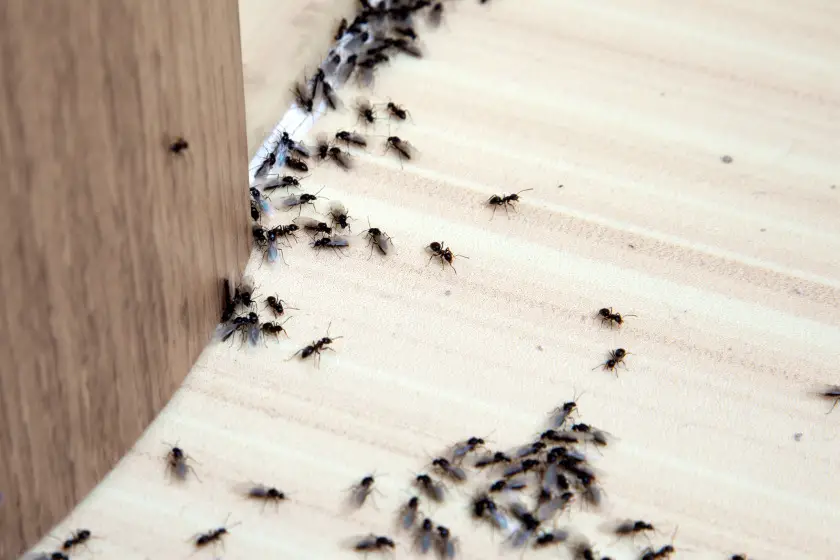Will Sealing Cracks Prevent Ants?
The presence of ants in your home can be a nuisance. Whether you’re dealing with black ants, carpenter ants, or fire ants, the question remains – will sealing cracks prevent ants from entering your home? The answer is yes, but it will take a bit of effort. Sealing cracks in walls, windows, doors, and other entry points will help to keep ants out of your home. It’s also a good idea to make sure that any food sources are sealed or stowed away, as ants are attracted to food. Keeping your home clean and free of crumbs and other debris will also help to keep ants from entering. However, sealing cracks is an important step in keeping ants out.

What Causes Cracks in Foundations
Cracks in a home’s foundation can be caused by a variety of factors, from the normal settling of a new home to the effects of extreme weather. When a foundation is exposed to rain, snow, or extreme temperatures, it can cause the soil to expand or contract, resulting in cracks. Additionally, if the foundation was not properly constructed, or if the soil was not adequately compacted, that can lead to cracks as well. Poor drainage, plumbing leaks, and poor landscaping can also contribute to the problem. It’s important to identify the root cause of the cracks in order to determine the best solution. Sealing the cracks may help to prevent ants from entering the home, but it is not a guaranteed solution.
How Sealing Cracks Can Help Prevent Ants
Ants are one of the most common pests found in homes around the world. As they search for food, they often end up in our kitchens and pantries. To keep them out, it’s important to seal up any cracks or openings in the walls and floors that they can use to enter the home. Sealing cracks can help prevent ants from entering your home, but it’s important to know how and when to do it.
The first step is to identify any cracks or holes in the walls and floors of your home. These can be small or large and can include any gaps or cracks between windows, doors, baseboards, and walls. Once you’ve identified the cracks, it’s time to seal them up. You can use silicone caulk or foam insulation to fill the cracks and seal them shut. This will create an impenetrable barrier that ants won’t be able to get through.
In addition to sealing cracks, you can also take steps to make your home less attractive to ants. Keep food stored in airtight containers and wipe down surfaces regularly. It’s also a good idea to keep your floors and counters free of crumbs and other debris that ants might feed on. If you take these steps, sealing cracks can help prevent ants from entering your home.
What Kind of Sealant to Use
Ants can be a nuisance and an unsightly problem in the home. Sealing cracks and crevices can help prevent them from entering the home and creating an infestation. However, it is important to know which kind of sealant to use.
When it comes to preventing ants from entering the home, it is important to use a sealant that is specifically designed to do the job. A sealant that is designed to be flexible and expand with the changing temperature is essential. The sealant should also be waterproof and durable. Silicone caulk is often the best choice as it is not only waterproof but also mildew and mold-resistant.
In addition to the sealant, a few other things should be taken into consideration. For instance, it is important to make sure that the area where the sealant is being applied is dry and free of dust and debris. This will ensure that the sealant adheres correctly and is able to do its job of keeping ants out. It is also important to check the area every few months for any cracks that may have appeared over time and to reseal them if necessary.
Using the right sealant and taking the necessary precautions can help prevent ants from entering the home and creating an infestation. Sealants can be a great way to keep ants out of the home and protect the property from damage.
When to Seal Cracks
Sealing cracks in your home can be a great way to keep unwanted pests like ants from entering and causing a nuisance. But when should you seal these cracks to be most effective? It can be tricky to tell when the right time to seal cracks is, as some species of ant are more active in different seasons. Knowing when to seal cracks to keep ants out is an important part of pest control.
First, inspect your home for any cracks that might allow ants in. Pay special attention to areas like window and door frames, around pipes and wires, and other small spaces. If you find any cracks, you should seal them as soon as possible. In general, the best time to seal cracks is in the spring and summer months, as this is when most ants are active. Sealing cracks in the winter months may not be as effective, as ant activity slows down.
When sealing cracks, be sure to use a high-quality sealant that is made specifically for pest prevention. Clear silicone caulk or an expanding foam are both good choices. They are easy to apply, long-lasting, and provide an effective barrier against ants and other pests.
Ultimately, sealing cracks can be an effective way to prevent ants from entering your home. By knowing when to seal cracks and using the right sealant, you can keep ants out and enjoy a pest-free home.
Other Considerations for Preventing Ants
Keeping ants out of your home requires more than simply sealing cracks and crevices. While sealing any cracks and crevices is an important first step, there are other considerations to keep in mind when preventing ants from entering the home. Sanitation is key, as ants are attracted to food sources. Make sure to keep food stored in airtight containers, vacuum regularly, and keep any exposed food off the floors. Additionally, make sure to repair any plumbing leaks and remove any sources of standing water. These can serve as breeding grounds for ants and other pests. Furthermore, keep an eye out for signs of ant activity, such as trails of ants or ant nests. If you do spot these signs, contact a professional pest control service to help you assess the situation and provide advice on how to get rid of the ants. Taking these steps can help you stay ahead of infestations and keep your home ant-free.
Conclusion
Sealing cracks in walls, foundations, and other areas of a home can help prevent ants from entering a home, as ants often use cracks to gain access to the inside of a building. However, sealing cracks may not be enough to completely prevent ants from entering a home, and other methods such as keeping food sealed and wiping up spills quickly should also be employed.







